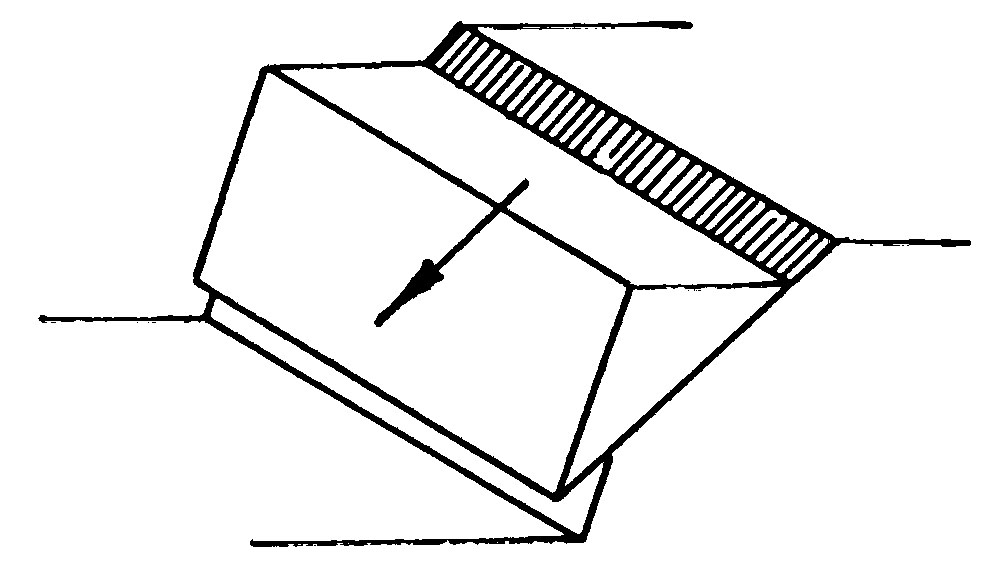26 April 2010
The mechanism of the Highway 3 landslide in Taiwan
Posted by Dave Petley
That bastion of “quality” journalism, the Daily Mail, has an article about the Highway 3 landslide that includes a set of high quality images of the site:
The article correctly identifies the failure as being a dip-slope slide:
“The hill had a dip slop [sic – should be slope] on the side nearest the motorway. The other side of dip slopes are steep and irregular, while the slope itself makes it easier for rocks to slide down, experts said. The Ministry of Transportation said it as [sic] investigating up to 20 similar dip slopes near major roads in Taiwan.”
A dipslope means that the beds in the slope were inclined sub-parallel to the slope surface, creating a plane of weakness on which sliding can occur, like this (from here):
The sliding surface can be clearly seen in the second image, though it was less steeply inclined than in the cartoon above. The inclination of the beds parallel to this surface on the displaced block is very clear. Excavation of the debris will have to be done very carefully indeed to avoid the upslope material slipping down onto the workers.
The lack of a trigger implies a progressive failure – but I am surprised in that case that signs of distress were not observed prior to failure.
Finally, it is interesting that the Ministry of Transportation says it is investigating “up to 20 similar dip slopes near major roads in Taiwan”. Having spent a great deal of time in Taiwan I would be surprised if there were just 20 such slopes, but maybe these are just the very large ones by major highways. The 18th August 1997 Lincoln Mansions landslide in Taipei, which killed 28 people, was also a dipslope failure, and the 2009 Shiaolin disaster was a wedge failure with a dipslope component.
The government really needs to get a grip of the management of slopes in Taiwan.





 Dave Petley is the Vice-Chancellor of the University of Hull in the United Kingdom. His blog provides commentary and analysis of landslide events occurring worldwide, including the landslides themselves, latest research, and conferences and meetings.
Dave Petley is the Vice-Chancellor of the University of Hull in the United Kingdom. His blog provides commentary and analysis of landslide events occurring worldwide, including the landslides themselves, latest research, and conferences and meetings.
I discussed a similar case yesterday. Previous analysis can be difficult.
Google has a nice set of high resolution street views of this cut. This link puts you looking at the exposed bedding planes.
[…] The mechanism of the Highway 3 landslide in Taiwan […]
The Three Gorges dam construction on the Yangtze River in China is the largest hydroelectric project in the world. After the first impoundment in June 2003, many landslides occurred or were reactivated. Shuping landslide is one of the most active landslides among them, which is a reactivated landslide occurred in shale and sandstone of Tertiary period. As soon as the first impoundment of the Three Gorges reservoir was conducted, serious deformation occurred in the Shuping landslide. It formed a large dangerous factor for the local residents and the shipment in the main stream of the Yangtze River. The deformation of the Shuping landslide is monitored by GPS extensometers; and crack measurements are summarized. Based on the monitored data, the deformation features of the Shuping landslide caused by water level changes are analyzed. Also, for the investigation of the groundwater situation, 1 m-depth ground temperature measurement was conducted; and the groundwater veins were estimated. It is found that there was no obvious deformation occurred in the head of the landslide. Extension deformation occurred in the upper part, and comparison deformation occurred in the lower part, while the deformation at the middle part was not obvious. As indicated in GPS monitoring results sooner after the impoundment of the reservoir, the lower part has faster displacement rate downward faster than that of the upper part. Currently, the displacement of the lower part was almost terminated while the upper part displaced downward gradually and compressed the lower part at the current water level. Through the investigation on the groundwater and comparison of deformation with rainfall data, it is estimated that the water level change of the Yangtze River is not the only affecting factor for the reactivation of the Shuping landslide. Groundwater condition of the Shuping landslide should also be further investigated.